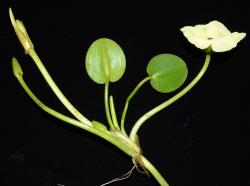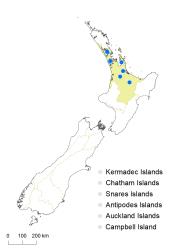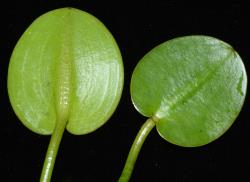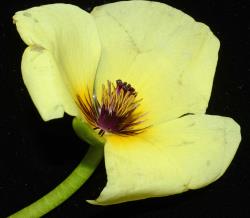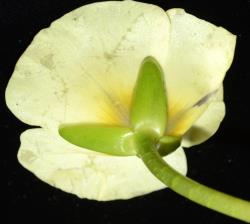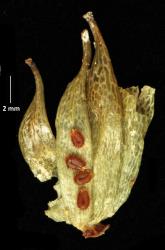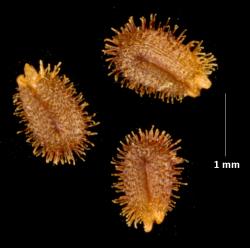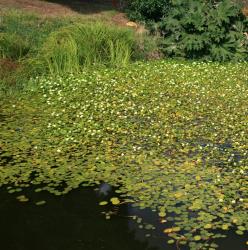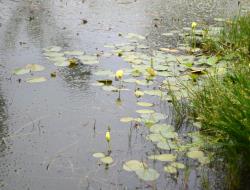- Taxon
- Weed
- ≡ Stratiotes nymphoides Humb. & Bonpl. ex Willd., Sp. Pl., ed. 4 [Willdenow] 4(2), 821 (1806)
Perennial aquatic herb with rosettes of floating or emergent leaves proliferating from stolons. Leaves long petiolate with sheathing bases; lamina 20–92 mm long, 15–95 mm wide, broad-ovate to orbicular, midvein swollen on the underside, coriaceous, shiny, glabrous, base cordate, sinus shallow; apex round to slightly mucronate, margin entire; petiole 60–490 mm long, 1.0–4.0 mm wide, terete, septate, glabrous. Flowers solitary to many, bracteate, 5.0–6.5 mm diameter, proliferating with leaves and stolons; pedicel terete 230–300 mm long, 3.0–3.5 mm wide, obviously septate, glabrous. Sepals green, 16–20 mm long, ovate to narrow-ovate. Petals yellow with dark yellow towards the base, 30–35 mm long, 32–40 mm wide, broad-obovate, apex round. Stamens up to approximately 30, filaments purple, 4–6 mm long, flattened, tapering, anthers yellow, 3–5 mm long, linear. Carpels 6–8, free, style attenuate from the ovary, persistent; stigma clavate, papillose, deep purple. Follicles 10–14.5 mm long, flask-shaped, brown. Many seeds per follicle, 1–1.5 × 0.6–08 mm, uncinate with a horseshoe-shaped embryo, covered with glandular trichomes, red-brown. Seeds not seen in New Zealand.
This species is distinguished by its showy, poppy-like yellow and purple-centred flowers with three petals on septate peduncles. Also, the midvein of the leaf-blade underside is obviously inflated and the leaves are shallow-cordate. Similar yellow-flowered aquatics are Nuphar lutea (yellow water lily, brandy-bottle), Nymphoides montana (marshwort) and N. peltata (fringed water lily). Nuphar lutea has larger, deeply cordate leaves and flowers with numerous tepals, not three petals. The two species of Nymphoides, N. montana and N. peltata, also have deeply cordate leaves, five petals, and distinctive fringed petal margins.
Ottelia ovalifolia (swamp lily), in the related monocot family Hydrocharitaceae, has many similarities to Hydrocleys nymphoides: three petals, a septate peduncle, similarly shaped leaf laminae (but more oblong) with primary parallel venation, but it can be distinguished from it by having white flowers, an absence of staminodes, an absence of an inflated midvein on the underside of the leaf-blade, and the presence of a distinctive, linear, submerged leaf-form.
Hydrocleys nymphoides is a designated unwanted organism in New Zealand under the Biosecurity Act, is banned from sale and distribution, and is targeted for eradication wherever it occurs.
North Island: Northland – Maungatapere; Auckland – Wellsford, Wharehine, Tauhoa, Laingholm, Glen Eden, Bombay, Pukekohe, Coromandel (Tapu River Valley), Cambridge, Te Aroha, Matamata, Tokanui; Volcanic Plateau – Rotorua, Lake Rotoehu, Te Puke.
Stagnant waters, farm and garden ponds, slow-flowing streams.
Notes: It spreads vegetatively by stolon fragments and can quickly establish dense mats of elastic stems.
CHR 3447, F. Neve, Te Aroha [c. 1914], cited in Cheeseman (1914).
Flowering: Feb.–Mar.
Notes: Apparently sterile in New Zealand, seeds never recorded (Healy & Edgar 1980p. 24–25).
2n = 16 (Rao 1953, Darlington & Wylie 1955).



